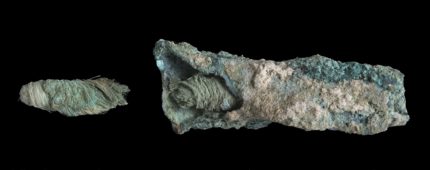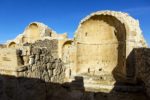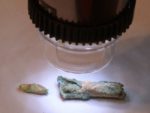Researchers at the Israel Antiquities Authority have uncovered a Byzantine-era lamp wick. At 1,500 years old, it is one of the oldest wicks of very few known to have survived. It was found at the ancient Byzantine site of Shivta south of Be’er Sheva, the flax material preserved by the arid climate of the Negev desert.

The wick was unearthed 85 years ago by American archaeologist Harris Dunscombe Colt who excavated Shivta in 1933-34. The ruins were first recorded in the 1860s and Leonard Woolley and his assistant T.E. Lawrence took detailed plans of the site in 1914-15, but Colt’s expedition was the first systematic archaeological exploration of the site. The city has elements of  Nabatean influence, primarily their characteristic desert management irrigation and agricultural techniques found at a farm next to the urban site. Aside from a few 1st century B.C. Roman structures, the archaeological remains in the city itself — churches, wine presses, homes, government buildings — are Byzantine.
Nabatean influence, primarily their characteristic desert management irrigation and agricultural techniques found at a farm next to the urban site. Aside from a few 1st century B.C. Roman structures, the archaeological remains in the city itself — churches, wine presses, homes, government buildings — are Byzantine.
Only a brief report on the Shivta dig in the 1935 issue of Palestine Exploration Fund Quarterly was ever published. The artifacts are now being studied for the first time as part of the Negev Byzantine Bio-Archaeology Research Program, a comprehensive examination of Byzantine settlements in the Negev led by University of Haifa professors. The wick was sent to the Israel Antiquities Authority laboratory for analysis last year.
Dr. Naama Sukenik of the Israel Antiquities Authority, who studied the wick says: “It seems that this rare find was preserved thanks to the dry climate in the Negev. Oil lamps played a key role in daily life in antiquity, illuminating homes and public buildings after sunset. Lamps made of pottery or glass are often found in archaeological excavations, but to find a wick from ancient times is rare. That’s because they’re made of organic fibers, which normally disintegrate quickly and disappear into the soil, as well as because they are so small and are usually consumed by fire.”
The wick was found in its holder – a small copper tube in which it was inserted when it was lit. Microscopic examination by Dr. Sukenik showed that the wick was made of linen, which comes from the flax plant and is known for its use in textiles and clothing as well as for wicks in oil lamps.
“The Mishnah [, the main book of Jewish legal theory], tractate Shabbat discusses what materials may and may not be used as wicks to light Sabbath lamps. There too, linen is mentioned as a high-quality material for wicks, because it burns long and beautifully. The Mishnah mentions other wicks, which were made of lesser quality materials and were therefore prohibited for use in Sabbath lamps. Among these were fibers made from the plant called Sodom’s apple, which to this day grows in the Dead Sea area. It seems that the inhabitants of Shivta also chose to light their public buildings with linen wicks. Because flax doesn’t grow in the Negev it probably came from farther north in the country through commerce,” Dr. Sukenik added.
 This wick was made of lower quality flax fibers. It was just a few centimeters long and meant to be consumed by fire, so might as well use the cheaper linen. The longer, more expensive fibers were saved for making clothes. It would have been used in a glass lamp, a simple cup or bowl filled with oil that was slurped up by the linen and provide fuel for the light.
This wick was made of lower quality flax fibers. It was just a few centimeters long and meant to be consumed by fire, so might as well use the cheaper linen. The longer, more expensive fibers were saved for making clothes. It would have been used in a glass lamp, a simple cup or bowl filled with oil that was slurped up by the linen and provide fuel for the light.
The wick in its bronze carrier and other artifacts unearthed by Colt and his team at Shivta will go on display at the Hecht Museum in Haifa staring January 24th, 2019.
Glad that all those finds were finally looked at! Who knows what great things are hidden away in storage all over the world.
Shivta is a beautiful site and really worth a trip for all you visitors to the HolyLand
Let there be LIGHT! :notworthy: The ‘hours’ may be referred to as divine services, and a book of ‘hours’ is called the ῾Ωρολόγιον. Despite numerous small differences, the overall order, it seems, is the same among Byzantine Rite monasteries.
——–
..Καθήλωσον ἐκ τοῦ φόβου σου τὰς σάρκας ἡμῶν, καὶ μὴ ἐκκλίνῃς τὰς καρδίας ἡμῶν εἰς λόγους, ἢ εἰς λογισμοὺς πονηρίας· ἀλλὰ τῷ πόθῳ σου τρῶσον ἡμῶν τὰς ψυχάς. Ἵνα διὰ παντὸς πρὸς σὲ ἀτενίζοντες, καὶ τῷ παρὰ σοῦ φωτὶ ὁδηγούμενοι, σὲ τὸ ἀπρόσιτον καὶ ἀΐδιον κατοπτεύοντες φῶς, ἀκατάπαυστόν σοι τὴν ἐξομολόγησιν, καὶ εὐχαριστίαν ἀναπέμπωμεν, τῷ ἀνάρχῳ Πατρί, σὺν τῷ μονογενεῖ σου Υἱῷ, καὶ τῷ παναγίῳ καὶ ἀγαθῷ καὶ ζωοποιῷ σου Πνεύματι, νῦν καὶ ἀεί, καὶ εἰς τοὺς αἰῶνας τῶν αἰώνων. Ἀμήν. …
From: Ἡ κατὰ σάρκα Γέννησις τοῦ Κυρίου – Ἀκολουθία τῶν Μεγάλων Ὥρων
[“Christmas”] (The ‘solemnity’ of the Incarnation of the Lord – Following the ‘Great hours’)
——–
In Paphos, in the ‘House of Aion’, there is a mosaic depicting the Birth of Dionysos (with Nectar and a female Ambrosia).
Of course, the whole thing, beginning with presents at December 6th up to Epiphany, with Saturnalia, the ‘Sol Invictus’ (etc.) is much older.
Epiphanius of Salamis [Bishop of Salamis in Cyprus, Oracle of Palestine, where he was born] for example, claims that -still- during his time in Egypt, at night between January 5th and January 6th, the ‘Birth of Aion’ by the virgin (Kore) was celebrated in a subterranean ‘Koreion’, with chanting the whole night trough. Then, with the crack of dawn, a shrine with 5 golden crosses was carried around (also cf. Suda).
So, based on a single wick find, Dr. Naama Sukenik deduces that the wick of choice for public buildings was linen?
A little less slapdash archeological analysis from archeologists, and we would have a much clearer idea of human history.
Comment by Trevor
2018-12-13 07:23:48
So, based on a single wick find, Dr. Naama Sukenik deduces that the wick of choice for public buildings was linen?
A little less slapdash archeological analysis from archeologists, and we would have a much clearer idea of human history.
—————————————————-
It’s the Israel Antiquities Authority, it’s what they do best. I’m surprised they didn’t claim the holder was inscribed with a biblical figure’s name, or have ancient grafitti on it saying “Moses was here”.
Frankly, I cannot really imagine that either the ‘Mishnah’ or any Byzantine agreement would ever have tolerated clothing made from something that is is referred to as ‘Sodom’s Apple’, while short fiber linen leftovers turned into a wick sounds pretty much reasonable even to me.
————-
PS: Contrastingly, in case you feel an urging need to strangle your enemy, Sodom’s Apple might just do.
I would call the material flax, not linen because it is just fiber which has not been spun or woven. Flax is the raw fiber, linen has been processed.
A technical difference but science is supposed to be precise.
And Mr. Frank, you are an expert on the IAA because…….?
Thank you for posting this article from Israel. I gladly welcome more entries about archeology from this region.
And as a subtext, let’s keep the critiques civil but informed.
I got a nice wick too. 😮